
The Lindisfarne Gospels is an illuminated manuscript gospel book probably produced around the years 715–720 in the monastery at Lindisfarne, off the coast of Northumberland, which is now in the British Library in London. The manuscript is one of the finest works in the unique style of Hiberno-Saxon or Insular art, combining Mediterranean, Anglo-Saxon and Celtic elements.

The Book of Cerne is an early ninth-century Insular or Anglo-Saxon Latin personal prayer book with Old English components. It belongs to a group of four such early prayer books, the others being the Royal Prayerbook, the Harleian prayerbook, and the Book of Nunnaminster. It is now commonly believed to have been produced sometime between ca. 820 and 840 AD in the Southumbrian/Mercian region of England. The original book contains a collection of several different texts, including New Testament Gospel excerpts, a selection of prayers and hymns with a version of the Lorica of Laidcenn, an abbreviated or Breviate Psalter, and a text of the Harrowing of Hell liturgical drama, which were combined to provide a source used for private devotion and contemplation. Based on stylistic and palaeographical features, the Book of Cerne has been included within the Canterbury or Tiberius group of manuscripts that were manufactured in southern England in the 8th and 9th centuries AD associated with the Mercian hegemony in Anglo-Saxon England. This Anglo-Saxon manuscript is considered to be the most sophisticated and elaborate of this group. The Book of Cerne exhibits various Irish/Celtic, Anglo-Saxon, Continental, and Mediterranean influences in its texts, ornamentation, and embellishment.

The Book of Deer is a 10th-century Latin Gospel Book with early 12th-century additions in Latin, Old Irish and Scottish Gaelic. It contains the earliest surviving Gaelic writing from Scotland.

The Cathach of St. Columba, known as the Cathach, is a late 6th century Insular psalter. It is the oldest surviving manuscript in Ireland, and the second oldest Latin psalter in the world.
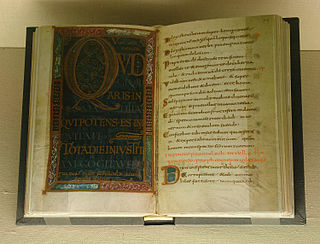
A psalter is a volume containing the Book of Psalms, often with other devotional material bound in as well, such as a liturgical calendar and litany of the Saints. Until the emergence of the book of hours in the Late Middle Ages, psalters were the books most widely owned by wealthy lay persons. They were commonly used for learning to read. Many Psalters were richly illuminated, and they include some of the most spectacular surviving examples of medieval book art.

The Black Book of Carmarthen is thought to be the earliest surviving manuscript written solely in Welsh. The book dates from the mid-13th century; its name comes from its association with the Priory of St. John the Evangelist and Teulyddog at Carmarthen, and is referred to as black due to the colour of its binding. It is currently part of the collection of the National Library of Wales, where it is catalogued as NLW Peniarth MS 1.
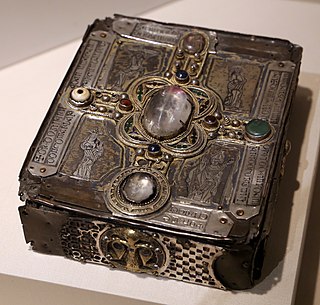
A cumdach or book shrine is an elaborate ornamented metal reliquary box or case used to hold Early Medieval Irish manuscripts or relics. They are typically later than the book they contain, often by several centuries. In most surviving examples the book comes from the peak age of Irish monasticism before 800, and the extant cumdachs date from after 1000, although it is clear the form dates from considerably earlier. The majority are of Irish origin, with most surviving examples held by the National Museum of Ireland (NMI).
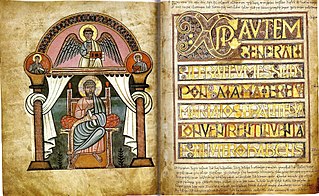
The Stockholm Codex Aureus is a Gospel book written in the mid-eighth century in Southumbria, probably in Canterbury, whose decoration combines Insular and Italian elements. Southumbria produced a number of important illuminated manuscripts during the eighth and early ninth centuries, including the Vespasian Psalter, the Stockholm Codex Aureus, three Mercian prayer books, the Tiberius Bede and the British Library's Royal Bible.
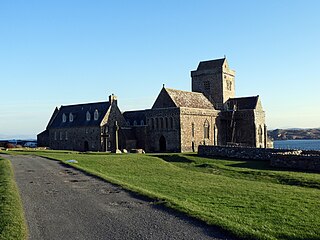
Iona Abbey is an abbey located on the island of Iona, just off the Isle of Mull on the West Coast of Scotland.
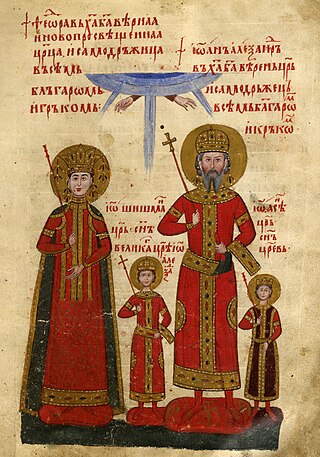
The Gospels of Tsar Ivan Alexander, Tetraevangelia of Ivan Alexander, or Four Gospels of Ivan Alexander is an illuminated manuscript Gospel Book, written and illustrated in 1355–1356 for Tsar Ivan Alexander of the Second Bulgarian Empire. The manuscript is regarded as one of the most important manuscripts of medieval Bulgarian culture, and has been described as "the most celebrated work of art produced in Bulgaria before it fell to the Turks in 1393".
The year 2006 in archaeology includes the following significant events.

The Parker Library is a library within Corpus Christi College, Cambridge which contains rare books and manuscripts. It is known throughout the world due to its invaluable collection of over 600 manuscripts, particularly medieval texts, the majority of which were bequeathed to the college by Archbishop of Canterbury Matthew Parker, a former Master of Corpus Christi College.

Palm-leaf manuscripts are manuscripts made out of dried palm leaves. Palm leaves were used as writing materials in the Indian subcontinent and in Southeast Asia dating back to the 5th century BCE. Their use began in South Asia and spread to other regions, as texts on dried and smoke-treated palm leaves of the Palmyra or talipot palm. Their use continued until the 19th century when printing presses replaced hand-written manuscripts.

The British Library is a research library in London that is the national library of the United Kingdom. It is one of the largest libraries in the world. It is estimated to contain between 170 and 200 million items from many countries. As a legal deposit library, the British Library receives copies of all books produced in the United Kingdom and Ireland, including a significant proportion of overseas titles distributed in the UK. The Library is a non-departmental public body sponsored by the Department for Culture, Media and Sport.
The title Trecheng Breth Féne "A Triad of Judgments of the Irish", more widely known as "The Triads of Ireland", refers to a miscellaneous collection of about 256 Old Irish triads on a variety of topics, such as nature, geography, law, custom and behaviour. Its compilation is usually dated to the ninth century.
The Glenmasan manuscript is a late 15th-century Gaelic vellum manuscript in the National Library of Scotland, Edinburgh, where it is catalogued as Adv.MS.72.2.3. It was previously held in the Advocates Library, Edinburgh, where it was classified as Gaelic MS LIII, and transferred to the National Library of Scotland on its foundation in 1925. The compilation contains Scottish Gaelic literary versions of tales of the Ulster Cycle, such as the Táin Bó Flidhais and Oided mac nUisnig.
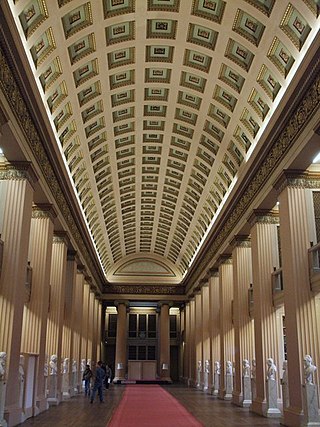
Edinburgh University Library is the main library of the University of Edinburgh and one of the most important libraries of Scotland. The University Library was moved in 1827 to William Playfair's Upper Library in the Old College building. The collections in Edinburgh University Old College were moved in 1967 to the purpose-built eight-storey Main Library building at George Square, one of the largest academic libraries in the world. Today, Edinburgh's university-wide library system holds over 3.8m books, e-books and e-journals in total.

The Munich Serbian Psalter is a 14th-century illuminated psalter written in Church Slavonic of the Serbian recension. With its 229 leaves illustrated with 148 miniatures, it is regarded as the most extensively illuminated Serbian manuscript book. It was written after 1370 in Moravian Serbia, either for its ruler Prince Lazar, or more likely, for his successor Stefan Lazarević. The book was rebound in 1630 by Serbian Patriarch Pajsije. It was taken to Bavaria in the late 17th century, and has been kept in the Bavarian State Library in Munich since the beginning of the 19th century.
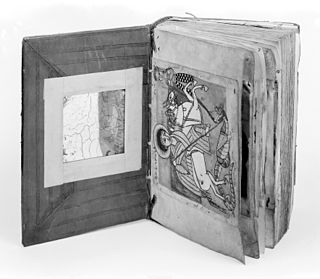
Ethiopian manuscript collections are found in many parts of the world, the monasteries and modern institutions in Ethiopia maintaining extensive collections with some monasteries still centres of manuscript production.
















